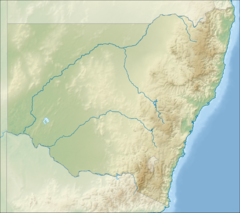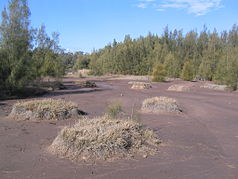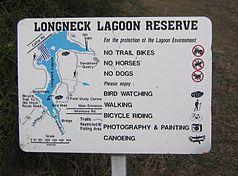Scheyville National Park
| Scheyville National Park | ||
|---|---|---|
| Northern swamp in the Longneck Lagoon | ||
|
|
||
| Location: | New South Wales , Australia | |
| Specialty: | Training farm military school marshland |
|
| Surface: | 9.2 km² | |
| Founding: | April 4, 1996 | |
| Longneck Lagoon from Cattai Road | ||
| A patch of mud in Longneck Lagoon | ||
| Information board on the loop around Longneck Lagoon | ||
The Scheyville National Park is a national park in the east of the Australian state of New South Wales , 41 kilometers northwest of Sydney . The Longneck Lagoon is located in the northern part of the park.
The cultural sights of Scheyville National Park touch on many topics of Australia's history since the beginning of European settlement. From 1804 the area was reserved as community property for the settlers in the area. The Pitt Town Cooperative Labor Settlement was established in 1893. It later became a farm for casual workers, where the unemployed could live and find work.
William Francis Schey , Member of Parliament for Redfern and Darlington , promoted this form of experimental agriculture by turning it into the Government Agricultural Training Farm . British youths who had agreed to come to Australia and wanted to become farm workers were trained there.
After the outbreak of World War II , the 73rd Australian Anti-Aircraft Searchlight Company and the 1st Parachute Battalion 244 of the RAAF were stationed there. During the post- war immigration wave in the 1950s, the buildings in Scheyville became the starting point for thousands of immigrants who wanted to start a new life in Australia.
1965–1973 the Officer Training Unit was stationed in Scheyville . A six-month intensive course designed to produce officers capable of leading a unit in the Vietnam War was offered to the soldiers. After many years of neglect and many suggestions for the further use of the site, Scheyville was finally declared a national park in early 1996.
history
Pitt Town Cooperative Labor Settlement
In 1802 an area of 22.9 km² was reserved as communal pasture for the settlers in the area. This area was initially called Nelson Common , and later Pitt Town Common . By 1889, the community area grew to 36 km² and extended from Maraylya to South Windsor . In 1893, the government divided a plot of 12 km² from the community property to build an experimental farm.
The purpose of this experimental farm was to reduce unemployment during the economic crisis of the 1890s. The new settlers were recruited from among the unemployed; among them were carpenters, gardeners, dock workers, warehouse workers and seamen, as well as their families. The Pitt Town Cooperative Labor Settlement and other cooperatives in Bega and Wilberforce were run according to socialist principles and were very controversial at the time. Today they are seen as an important step in building trade unions and the labor movement in Australia.
Government Cooperative Labor Settlement
In 1895, William Francis Schey, a member of the New South Wales Parliament, proposed the establishment of another type of government-sponsored farm in place of the Pitt Town Cooperative Labor Settlement. The farm was used as a short-term refuge and place of work for men who were unemployed or sick until they recovered or found work in the city. The men were not allowed to stay longer than 4 months and during this time received a small wage for the work they carried out on the farm.
Decisive improvements were made to the farm in the years 1896 to 1905: buildings and fences were repaired, a silo was built, a cattle and pig sty were in operation and the farm was able to support its residents. Between 1905 and 1910 the farm became more of an agricultural training facility, and the town boys who were introduced to agriculture there easily found work in the countryside. In memory of Francis William Schey and his commitment to social welfare, the area of the farm was renamed Scheyville .
Dreadnought Scheme
The Dreadnought Scheme was a program to encourage and support British youth who wanted to become farm workers in Australia. Funds raised for the procurement of a warship were diverted to the establishment of the Dreadnought Scheme when the Commonwealth of Australia decided to build its own Australian Navy instead.
Upon arrival in Australia, the teenagers were taken to a state farm for three months for agricultural training. More than half of the young people who participated in this program were sent to Scheyville. Here the boys learned skills such as shearing sheep, riding, growing grain, dairy farming, butchering and the care and repair of agricultural equipment. After this training, the boys could be sent to any farm in the country. Most of the Dreadnought Scheme graduates came from farms in northeast New South Wales.
With the beginning of the First World War , the Dreadnought Scheme was discontinued. During the war, the farm was briefly used to intern 87 German citizens who were arrested by German ships that were anchored in Sydney Harbor when the war broke out. Australian women were later trained there in farming skills while their husbands were at war.
1921 Dreadnought Scheme was revived, but was in 1930 due to the great world economic crisis set again. By then 4,500 British youths had been trained in Scheyville. During the Great Depression, the farm took over 500 local Australian youths a year and trained them in basic farming skills for 4 months each. After this training, the boys were placed in suitable jobs on farms, where they could complete their training. The Scheyville training farm era ended in 1940 when the farm was taken over by the Commonwealth of Australia as a military school during World War II.
Second World War
In October 1940, the Australian government requisitioned the Scheyville farm. An artillery and anti-tank school was established there. On September 15, 1942, the 73rd Anti-Aircraft Searchlight Company (AASL) was stationed in Scheyville before being moved to Brisbane on November 6, 1942 . The 1st Parachute Battalion 244 occupied the farm from late 1943 to late 1944.
Officer training
In 1965 the complex was again taken over by the military and used for army training purposes. At that time, Scheyville was used for an officer training unit (OTU) for conscripts. This was the only unit in Australia to offer this focused, six-month course.
The training at OTU Scheyville was specifically designed to produce officers who could lead units in the Vietnam War. It was very intense and consisted of six working days a week with 10-14 working hours a day as the norm. It consisted of a lot of theoretical lessons and also hard physical training. Many of the officers trained in this way served in Vietnam.
Many of the OTU graduates became well-known military leaders in their own branches, saying that the Scheyville training was a major contributor to their professional success.
Cadets who entered the Air Force directly were also trained in Scheyville, in the same six-month courses as the conscripts. There were also twelve-month courses (January – December 1972 and July 1972 – June 1973). The first six months of these courses were the same as for the conscripts and the last six months were more geared towards the graduates' later deployment in the regular army. The OTU remained in operation until 1973 (the last recordings were in October 1972) until the Labor Party abolished conscription in December 1972.
The Hawkesbury Agricultural College opened a campus in Scheyville for five years in 1978, but then did not renew the lease.
Web links
Individual evidence
- ^ Scheyville National Park . Office of Environment & Heritage. NSW National Parks and Wildlife Service ( Memento of the original from August 20, 2006 in the Internet Archive ) Info: The archive link was automatically inserted and not yet checked. Please check the original and archive link according to the instructions and then remove this notice.
- ↑ Scheyville National Park and Pitt Town Nature Reserve Plan of Management Office of Environment & Heritage. NSW National Parks and Wildlife Service ( Memento of the original from August 25, 2006 in the Internet Archive ) Info: The archive link was automatically inserted and not yet checked. Please check the original and archive link according to the instructions and then remove this notice.




